The HTC One (M8) Review
by Anand Lal Shimpi & Joshua Ho on March 26, 2014 7:00 PM EST- Posted in
- Smartphones
- HTC
- Mobile
- HTC One
Return of the UltraPixel
As I mentioned earlier, the One’s primary camera sensor remains unchanged from last year’s model. The M8’s primary shooter is a 4MP “UltraPixel” camera with 2.0µm square pixels. As Brian (correctly) theorized last year, there were two sources for HTC’s UltraPixel camera: ST (VD68969) and OmniVision (OV4688), the latter being the limited second source. Due to quality control problems with the ST sensor the M8, like later models of the M7, uses the OmniVision sensor exclusively. The entire module is almost identical to what we saw last year in the M7, with one notable exception: it no longer has OIS (Optical Image Stabilization). Dropping OIS was likely due to a combination of cost and performance concerns. HTC’s OIS was never quite as good as Nokia for example, and there’s surely an impact on yield. I’m curious as to whether or not we’ll see it return in a future flagship, but for now the feature is gone.
The impact is obvious. I carried both versions of the One (M7 and M8) and recorded some video while walking around RDU. The lack of OIS has a tremendous impact on image stability while recording a video:
The impact on still photography is also significant, although it’s easier to mitigate through tuning of the camera software.
HTC is quick to point out that although the camera sensor and lens system haven’t changed since last year’s model, they are backed by an improved Qualcomm ISP (Snapdragon 801 vs. 600). HTC maintains the dual-ISP approach with both its own Imagechip and Qualcomm’s integrated ISP working to process sensor data. It’s unclear just how different the underlying ISP architecture is in Snapdragon 801, however it is considerably faster (930MP/s vs. 320MP/s).
The camera UI has been substantially improved (not that it was bad to begin with). With enough light, the preview appears to be full res, accurate and at a high frame rate. In lower light the preview will drop frames as it attempts to maintain visual accuracy.
A full pass of the autofocus routine should take around 300ms. There’s virtually no capture lag as images are dumped directly from a capture buffer to NAND. Burst capture is supported, just hold down the capture button and the One will grab a maximum of 99 frames at a rate of around 12 fps. HTC offers a best shot button that will analyze all 99 frames, determine the best one and delete the rest. You can also use HTC’s Gallery to quickly select and delete all photos.
HTC continues to do an excellent job with the software tuning of its camera. The One’s auto mode is really good. There do seem to be some tweaks compared to the M7’s camera software (above and beyond mitigation for the missing OIS), for example color accuracy is improved on the M8. There's also a new dual flash, similar to what's in the 5s.
The whole point of HTC’s UltraPixel sensor was to capitalize on the fact that most of the time we’re taking these ultra high resolution photos on our phones, only to have them reduced to less than 1MP and shared on the web, Facebook or Twitter. If that’s your primary use case, the One’s camera is really one of the best, most versatile shooters on the market. HTC’s 2.0µm square pixels enable great low light performance.
Performance in well lit scenes is also more than reasonable if you’re talking about sharing for the web at reduced resolutions:
The problem becomes when you start trying to share at full resolution:
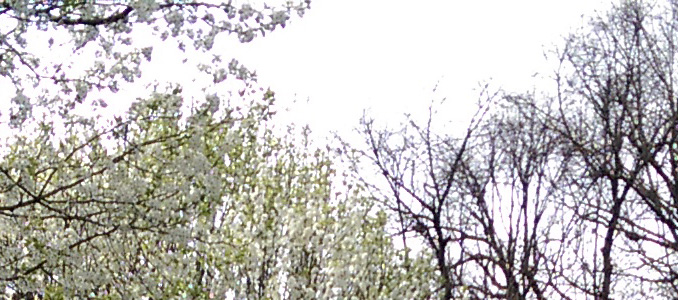
The fact remains that there are more pixels on a 15-inch MacBook Pro’s Retina Display than you can get out of the One’s UltraPixel camera. On the M8 in particular, you actually get higher resolution shots from the front facing camera than you do out of the rear.
If you look back at last year’s coverage of the M7, you’ll find large pockets of people who were put off by the sensor’s lack of spatial resolution. Unfortunately HTC did nothing to address this weakness with the M8.
One complaint I definitely had about the previous One was its insistence on driving to higher than needed ISO values when in really low light scenarios. I remember being so incredibly pleased with this shot taken with the M7, but having to manually set the ISO to 200 in order to get it.
With the new One, HTC seems to do a slightly better job of choosing ISO levels in auto to begin with. If it goes too aggressive however, HTC now offers an easy way to cap max ISO with an Auto Max ISO setting. Previously the ISO toggle was in the settings menu and only forced a single value, now with Auto Max ISO you can set the absolute maximum ISO level you’d like the camera to use and it’ll choose any value up to but not exceeding that.
HTC continues to limit the minimum ISO level to a fairly high value of 100. I’m not entirely sure why this is, but there’s definitely a negative impact on performance in scenes with lots of light. Both Apple and Samsung by comparison can go down to much lower ISO values.

If you need more control over the M8’s camera, HTC now exposes full manual controls for ISO and shutter speed, in addition to white balance, exposure and focus point. The UI is reminiscent of Nokia’s Camera+ manual controls. Tap on any of the values you’d like to adjust and you’ll get a vertical slider. The UI isn’t entirely intuitive. Instead of dragging down from the red A (which won’t work), you slide up from the bottom or tap directly on the desired value. The manual controls won’t hide automatically either, so tap on a few of these things and your camera preview becomes crowded with adjustments.

The biggest problem is that HTC attempts to give you a live preview reflecting the settings you’ve chosen. Drop shutter speed down too low and you’ll get a camera preview that’s effectively unresponsive as it updates the display in line with your shutter speed. HTC’s head is in the right space though, exposing full manual controls is a great step forward - it just so happens that HTC’s auto mode is good enough to not have to rely on them.
The One’s HDR mode requires around 2.5 seconds from the moment you capture until it’s done processing. The multi-exposure HDR still produces blown out highlights in bright scenes, somewhat defeating the point of HDR photography to begin with.

Not all situations are terrible for HTC's HDR mode however. In this setup below, I actually get more detail in the shadows and highlights rather than just one:

Overall HTC’s more aggressive HDR definitely increases detail in the shadows, but often fails to preserve detail in highlights.
Switching between front and rear cameras is a simple downward swipe (and the same to switch again). Switching between other modes is similarly quick by using the new camera selector button in the lower right of the UI. Tapping it will bring up this screen exposing all six modes supported by the camera:

Pretty much all of the modes here are self explanatory, though there are two I want to focus on in particular. HTC’s Zoe camera was a big focus of the original One, and it’s obviously back here with the M8. Instead of Zoe being an awkwardly placed button on the left side of the camera UI, it’s now a separate camera mode.
Just as before, you can use the Zoe camera to capture full resolution stills or 1080p30 video. Tap the capture button and you’ll dump a still just like in the standard camera. Hold the capture button down and you’ll record a short, vine-like video as well as capture 20 stills in tandem. Unlike Zoe on the M7, the short videos aren’t of a fixed length. The M8’s Zoe camera records video as long as you have the capture button depressed, and after a short while it’ll lock into recording letting you free up your finger. The Zoe experience is much better on the new One.
The M8’s Gallery app automatically grabs photos, videos and short videos recorded with the Zoe camera, adds some filters and background music and creates a short 30 second highlight of your event/day. There are a number of predefined themes, but you can also add your own music, select start/end photos and directly control what content appears in the highlight. The real beauty of the feature is that if you don't want to do any of that, you don't have to - the One will automatically put together a highlights reel without any user intervention.
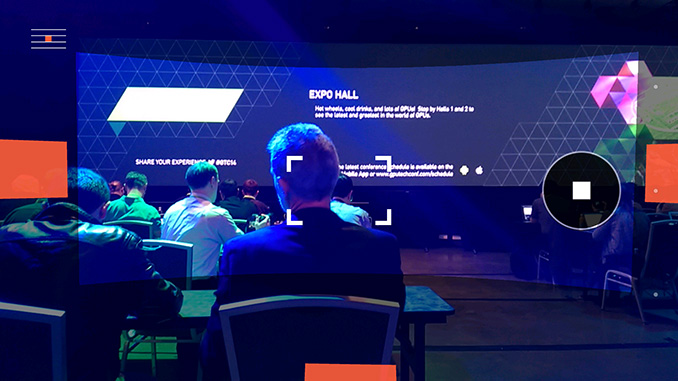
The Pan 360 mode lets you stitch together awesome panoramas with an incredibly easy to use UI. The tool just presents a bunch of red boxes on the display, line up the focus target with each box and it'll automatically capture/move to the next one. You never have to hit the shutter button.
5MP Front Facing Camera
The front facing camera uses a 5MP Samsung S5K5E sensor with 1.12µm pixels. The rear sensor is still capable of better images, but it is sort of funny that the front facing camera has a higher resolution sensor than the primary shooter. It's interesting just how important the front facing camera has become in recent times. Moving to a 5MP sensor on the front of the M8 is something that would've been unheard of not too long ago.
|
Front Facing Camera
|
Rear Facing Camera
|
|
1520 x 2688 - 2.5MB (1.65MB without Duo Cam)
|


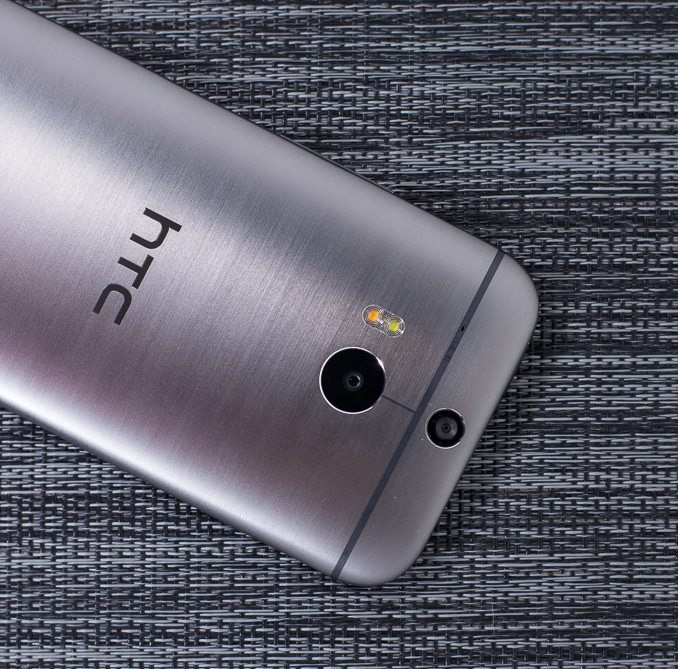
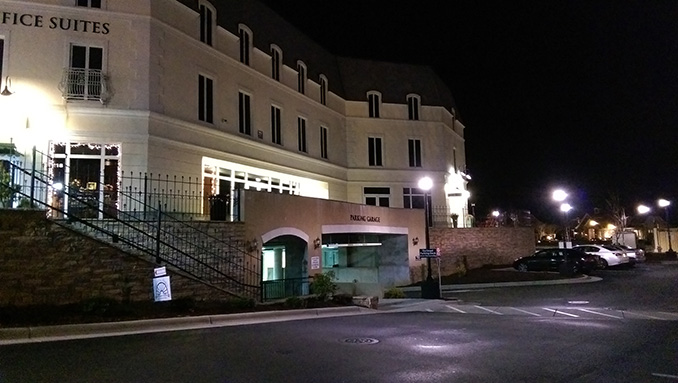
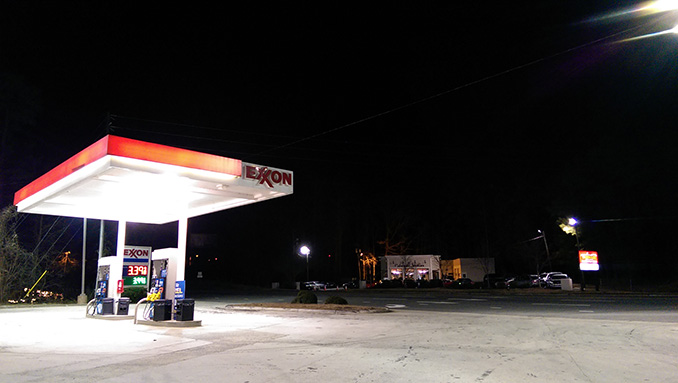

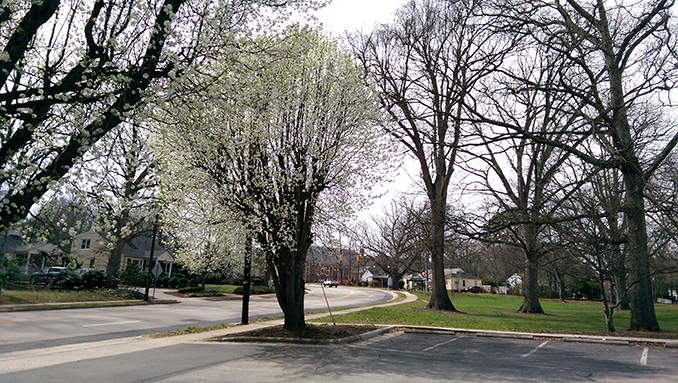










































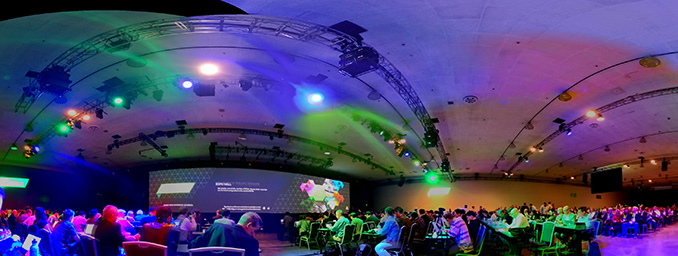

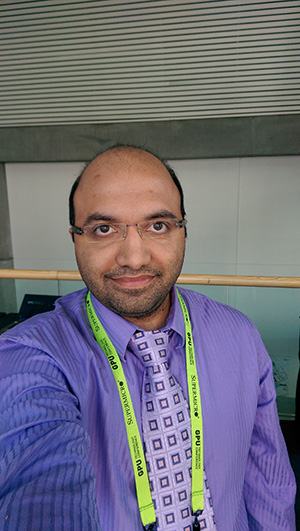








222 Comments
View All Comments
jonup - Friday, March 28, 2014 - link
My point exactly! I was not arguing that the One has the best or better camera than the other flagships. All I said is that people a bashing the phone over a camera that is good enough (ok if you wish) in the day light but it (the phone) is exceptional in any other way (save for the wasted real estate by the logo). I would give up 600mah of battery to get rid of the black stripe underneath the display. Which brings me to the other Samsung sponsored reviewers argument - on screen keys vs capacitive key. On-screen keys is the Google way. Not the iOS Samsung copy cat way. I wish there is more custom-ability in the GEL and in the OEM laucher to set height of the nav bar, the width of the buttons, and the choice of buttons. As usual my two cents.mkozakewich - Sunday, March 30, 2014 - link
It doesn't take steady video, which is where it's more important. All the regular photos in this article were still shots, except for the video demonstrating the difference between the M7 and the M8.sephirotic - Sunday, March 30, 2014 - link
4k recording is worse than gimmick on any 1/3" sensor. Compression efficiency on smartphones is very low and unoptimized for video, there is simply no way to retain actual 1080p motion resolution with currect processors and pixel pitch of 1/3 sensors. Z2 samples makes this obvious, Actual true resolution on Z2 is worse than a semi-professional 720p video on a 2010's GH1. I'd rather have a more efficient 1080p compression and slow motion than 4k. EVEN IF there was actualy improvement from 1080p videos on 4k recorded from smartphone, 99% of regular costumers woudn´t even have a 4k screen to display it. Using for mastering casual videos? Even less likely.4k video on smartphone is just plain idiotic.
However I do agree 4mp is a little on the low side even for 1/3" sensor but no doubt pushing anything beyond 8mp is pure gimmick. it's a shame that sony kept pushing the megapixel race for so long even after the other manufactures stoped with this nonsense and now this is back on Smartphones and Video.
I do agree removing OIS is sad drawback.
CoryWeston101 - Monday, March 31, 2014 - link
Let's get some facts straight. NO ONE NEEDS 4K recording on a smartphone or period. Less than 1 percent of the poulation has 4K TVS or monitors making 4K recording a useless gimmick. You need it that badly go by an actually 4K camera from Sony or Cannon or someone. It will do a better job. But 4K recording is a stupid useless gimmickThey took OIS out because of the 2 camera set up. And also with a 2 camera set up YOU DON'T NEED OIS as it essentially does the same thing only better. The camera is a giant leap forward And no that's not why it is getting knocked. It is getting knocked because of the uneducated people out their like.
You bring the Moto X up? The Moto X camera sucks. The M8 camera makes the X camera look like a childs toy.
The M8 has one of the best cameras on a smartphone. They did not regress. They progressed. You are just to daft to understand.
CalaverasGrande - Monday, March 31, 2014 - link
4k recording on your smartphone?What phone DOES do that now.
Anand R - Tuesday, April 1, 2014 - link
You want 4K recording? What for? Do you have a 4K screen? Besides, even if you do, why not use an actual camera for 4K recording (which would be better in every way) rather than use a phone camera?purerice - Saturday, April 12, 2014 - link
Complaining about lack of recording 4K... on a cellphone... with 16GB total storage...Please tell me you forgot the "/sarcasm" tag.
Few cell phone cameras can compare to even a low end PaS camera in good light. Reduce the light level, increase the distance, add some motion, and the point&shoot wins by leaps and bounds. Olympus and Panasonic make decent all-weather cameras that fit in your pocket for 1/2 the price of a flagship cellphone.
If the phone has a good enough camera for video calling and quick snaps, it's good enough for me. I would no more replace a real camera with a cellphone because the cellphone can remedially take photos, than I would replace a computer with a cellphone because my cellphone can remedially edit spreadsheets.
doosh bag - Thursday, March 27, 2014 - link
I totally agree. The camera is more than capable enough in the opinion of professional photographers, but these nudniks out here, these spec snobs can't seem to find anything better to do than regurgitate the same tired, flimsy rhetoric, they read from some meshuggah reviewer, again and again. Far as I can gather from the comments on this first page, none of these yentas even own a M7 or a M8. It's all third person narrative. I own the M7 and let me tell you something, that camera is boss. For example, I was driving down the interstate in the desert, around 70 mph, driving into a beautiful sunset. I held the phone up to the side window and held the shutter button for a few seconds. Got about 20 shots. In one shot there was a semi truck going by, in the opposite direction, in the farthest lane away from me, traveling roughly the same speed, about 200 feet away, in failing light. So, combined speed between the two of us, about 130 mph. I snapped these photos in portrait mode. The picture looked as if everything were perfectly still. The detail so sharp that, without zooming the photo at all or flipping it to landscape view, I can clearly see and count all the lug nuts on the front wheel of that truck. There is nothing wrong with that camera. That camera does everything it's supposed to do and it does it exceptionally well. It's every bit as good as most, and almost as good as some. Comparison after comparison has proven it to be more than adequate. Someone mentioned 4K recording. Let me explain something to you people. 4K is a gimmick. It's a joke. 4K went be commercially viable for another 5 years, if then. They don't even have proper codecs to deal with it. Still using HD codecs to render Ultra HD source code. No phone can render the 4K video it shoots. Televisions and monitors are extremely expensive.puremind - Saturday, March 29, 2014 - link
I also totally agree. The M7 convinced me more in terms of shooting clean blur free, fast focused pictures. Other phones have let me down big time. MP give you sharper pictures if you are lucky... That's 30% of the time. I have regretted not being able to crop but I liked thetrade off of faster shooting.Death666Angel - Friday, March 28, 2014 - link
"If you are into photography that you care so much about picture detail, you won't be using you phone to take pictures."That is such a stupid argument. Considering that smartphones are alround devices capable of many things, you can say that just about every feature;
- if you care about high speed browsing, you will use a laptop/desktop
- if you care about listening to music, you will use headphones/DAC/dedicated mobile players
- if you care about video chat, you will use a 4k camera and a high end beamer
That do a lot and thus nothing really spectacularly. But that's not the point here, is it?